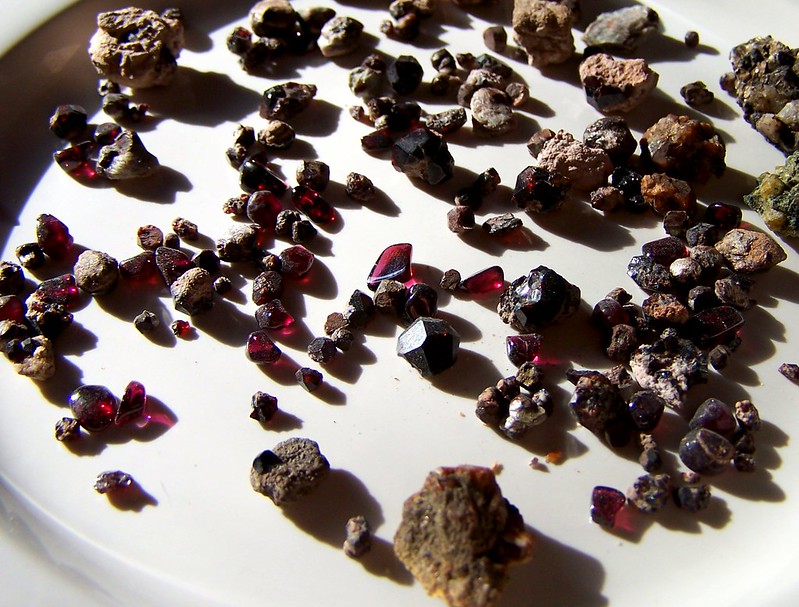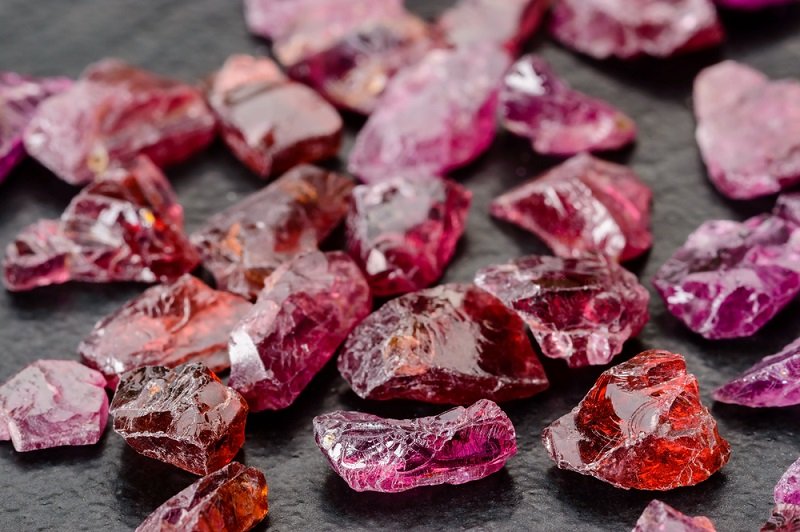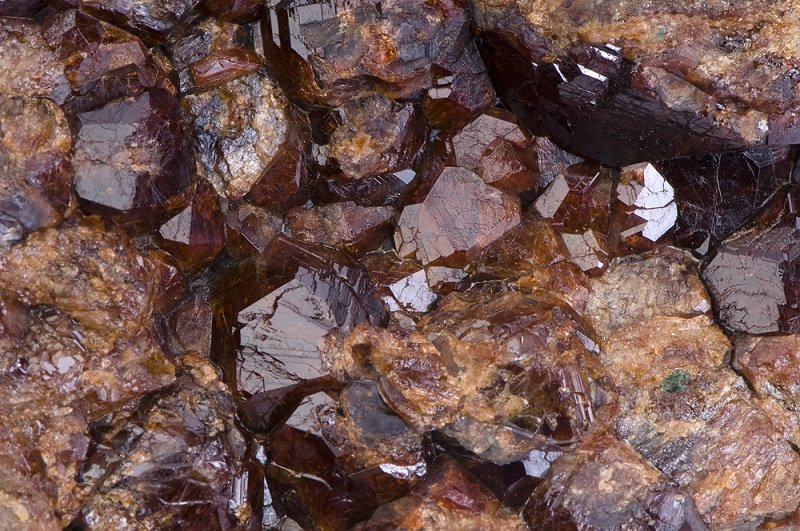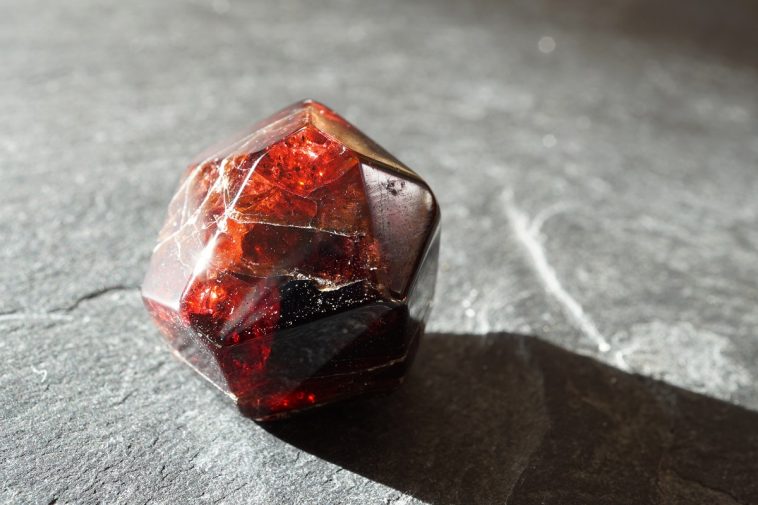Ah, garnets. While typically known as a red gemstone, these fascinating gems actually come in a wide variety of different colors depending on their individual species. There’s a lot of ground to cover for someone new to collecting them.
What Are Garnets?
Garnets are one of the oldest known gemstones and have been used since antiquity for both their beauty and hardness. The latter, in particular, made them useful to the ancients since garnet could easily be fashioned into an abrasive.
These days, most of us know garnet as a deep red gemstone. That’s not strictly the case, and even if we’re talking just about red garnets there’s a ton of variety.
These cut gemstones are all garnets, despite the color differences.
Garnets have a variable chemical composition, which makes them a bit unique. This family of gemstones is always a silicate (SiO₄) with two other elements. Thus, “pure” garnet is always XₙYₙ(SiO₄). The X and Y groups are used to determine the family of garnet the stones fall into.
Garnet has a long history of use. These days they’re mostly used in jewelry, diamond dust and corundum are both superior abrasives and readily available. That makes garnet a bit less useful as an abrasive than they were in the past.
One place where industrial garnet still has the edge is in waterjet cutters. These are machining devices that use ultra-high pressure water and an abrasive to cut through most materials. In this case the Moh’s hardness of 7.5-8.5 (specifically with almandine garnet) is perfect.
The garnet is harder than most metals and stones, but softer than the tungsten carbide used to create the cutting head. Corundum wears these down quickly, and diamonds can destroy them in a fraction of the time.
Garnets are common gemstones across the world, although not every variety ends up being highly desirable.
Garnets are one of the few gemstones other than the quartz varieties that are both cut into gemstones and kept as specimens for their own value. Most junior rock collectors remember the common garnet in mica or schist formations that came with almost every collectors’ starter kit.

What Type of Garnets Are There?

Identifying garnets gets… complicated. The reason is that garnet describes a wide variety of different minerals, with different colors and chemical compositions.
The archetypical garnet is a deep red, but they can be found in pinks, purples, greens, and there are even extremely rare blue color-changing garnets.
Garnets are considered a mineral family, and there are quite a few different sub-types depending on chemical composition.
Do you want to make things even more fun?
Almost no garnet is a pure crystal one sub-type, which leads to intermediate varieties as well. It can all be a bit overwhelming for those who are new to collecting.
Remember that garnets are all XₙYₙ(SiO₄).
Essentially, we have two main varieties of garnet:
- Pyralspite Garnets- These varieties have aluminum in the Y site of their chemical makeup.
- Ugrandite Garnets- These varieties all have calcium in the X site of their chemical makeup.
Each of these has subtypes, leading to the varieties of garnet we know.
Pyralspite garnets are the following types:
- Almandine Garnet (Fe3Al2(SiO4)3)– An iron and aluminum bearing garnet. Almandine garnet is the most common gemstone garnet and most specimens display a deep red color. It’s also commonly used as an abrasive in some industrial processes when not cut into faceted stones for jewelry.
- Pyrope Garnet (Mg3Al2(SiO4)3)- Pyrope garnets contain magnesium and are almost always deep red in color. This coloration can get very deep, becoming almost black, in some cases.
- Spessartine (Mn3Al2(SiO4)3) – Spessartine garnets contain manganese in the X placement and are usually an orange-ish color. Violet-red varieties are found in some places.
You also have some combinations of the above that lead to differing effects. For a collector, the two main varieties of interest are:
- Rhodolite Garnet- A purple-colored garnet found in Colorado. Rhodolite garnets are a combination of pyrope and almandine garnets.
- Color Changing Blue Garnets- Pyrope-spessartine garnets occur in a dominant blue that shifts to green due to high vanadium inclusions. These are the rarest garnets and can fetch incredible prices.
We’re not done yet, of course. Ugrandite always has calcium in the X position and the following varieties are recognized:
- Andradite (Ca3Fe2(SiO4)3)- Andrabite garnets contain calcium and iron. These formations produce some of the most highly sought-after garnets, such as the bright green demantoid variety.
- Grossular (Ca3Al2(SiO4)3)- The grossular variety encompasses several varieties of green garnet, including the famous Tsavorite garnets. They also come in brown, yellow, and red varieties.
- Uvarovite (Ca3Cr2(SiO4)3)- A rare, bright-green garnet that contains chromium, uvarovite is highly sought after. The crystals are rarely large enough for faceting but the bright green makes even sliced mineral specimens of the host rock attractive enough for jewelry.
Among the ugrandite garnets, the main thing to remember is that all green garnets fall under this category. Tsavorite and demantoid garnets rival traditional precious stones in price, but mineral specimens of all three ugrandite garnet types are reasonably priced.
These aren’t every variety of garnets, but they make up the vast majority of those found on the market. The others don’t produce gem-quality stones, so they’ve been of less interest to the majority of jewelers.
Garnets are among the most complex gems in the business, this is just a brief overview. If you’re interested in them from a gemological standpoint I recommend checking them out at the Gemology Project for a scientific starting point.
Where Can I Find Garnets?

Garnets are found across the world. They’re a rather common mineral as a general rule, but the different types of garnet are found in specific locations.
The majority of garnet found in the United States is used for industrial purposes. That said, there are some amazing quality gems pulled from US soil.
The following states all have garnets of interest to the collector:
- Idaho
- California
- North Carolina
- Arizona
- Colorado
- New York
When you get into the history of garnets in the United States you’ll find that many attempts have been made for mining garnets, but a lot of the deposits simply didn’t have commercial potential.
Their widespread nature leads to garnets being found in many areas, and they’re a frequent find when panning in creeks.
Idaho is one of two places in the world where star garnets can be found. These burgundy-to-black gemstones are cut into rounded shapes and display asterism.
The other mine of major concern is in North Carolina, specifically in the Cowee Valley. The area produces incredible rhodolite garnets, varying from soft pink to deep purple-red in their coloration.
The United States does have some varieties of grossular garnet that run from pale green to apple green. Unfortunately, there don’t appear to be any deposits of the highly valuable tsavorite garnets in the US, the green species found here is grossularite.
Southern California, in areas near San Diego, has spectacular orange spessartine garnets as well.
Garnet is sometimes found alongside sapphire deposits, such as those in Montana as well.
While gem grade material isn’t common, there are a ton of accessible garnet deposits across the United States.
How Do I Find Garnets in the Field?
Garnets are usually small crystals, and finding them usually takes more work than just strolling through a riverbed. There are two main ways that garnets are found: panning and pegmatite mining.
Pegmatite Mining for Garnets
Breaking down pegmatites for crystals is a common rockhounding activity, but it does require some equipment.
You’ll want the following:
- Safety glasses or goggles
- Rock pick
- Shovel
- Sledgehammer
- Cold chisel
Pegmatites are large formations of igneous rocks that create a conglomerate. Contained within you can often find crystalline specimens, including garnets.
Breaking down pegmatites for crystals is an easy process, but it can be time-consuming.
You’ll want to break off pieces and then open them, looking for any crystals locked into the matrix. Garnets are often less red and closer to black when initially found, but they occur frequently in some pegmatites.
Use the rock pick to pry bits off where you can, and the hammer and chisel to break bits out. Work carefully and slowly, and don’t create an overhang if you’re working into the side of a larger pegmatite. Things can get dangerous quickly if you have stone above you.
For those less inclined to hard rock mining, you may not be out of luck. In many areas the exposed pegmatites have eroded over time, creating a small field of igneous rocks with crystals trapped within.
Look for mineral samples of garnet from the area online so you know what you’re looking for, garnet crystals have a variable appearance.
Pegmatite mining takes a lot of effort, and you need to be in the right location but it’s one of the best ways to find high-quality specimens.
Panning for Garnets
Garnets often occur alongside gold, and most prospectors have found a few mixed in with the yellow stuff. The neat part is that you stand a good chance of finding more than just garnets.
Over time water breaks down many minerals that may contain gold. Pyrite, for instance, is water-soluble and a significant chunk will dissolve in a couple of years in a stream. That releases the tiny amounts of gold held in the matrix, allowing any larger pieces to be found later.
That also happens to many of the stones which contain garnet. Skarns, for instance, erode over time and release the harder garnets which can be found later.
Garnets’ close association is enough that many would-be gold miners just end up with a vial full of garnets at the end of the day even if they missed gold.
So, you can pan for garnet in most places that contain gold. The majority of garnets found this way are pyrope garnets, which are usually deep to bright red.
It’s a “side-catch” for many gold prospectors, but something to keep in mind if you live near an area associated with gold or garnets. Both can be pulled from the same streams, and often at the same time!
- Online rock and mineral club for collectors of all levels!
- Find community with like-minded rock and mineral enthusiasts.
- Monthly Giveaways!
- Free Access to Entire Digital Library of Products (current and future products)*



